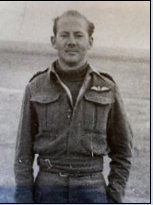Navigation: Alers Hankey > Miss Alers > William Alers > Stephen Alers > Walter Childe Alers > Cecil George Herbert Alers >
1915 - 1943
Born 17th Aug 1915
Died 17th Dec 1943

Flight Lieutenant Stephen Alers HANKEY (40822)
Stephen Alers Hankey was born at Westhampnett in Sussex on the 17th of August 1915 the third and youngest son of Colonel Cecil George Herbert Alers Hankey JP DL (Sussex), Royal Sussex Regiment, and Gertrude Clare (nee Fetherstonhaugh) Hankey of Binderton House, Chichester in Sussex.
He was educated at Lancing College where he was in Fields House from September 1929 to 1934. He was a Corporal in the Officer Training Corps where he achieved Certificate A in 1933 and was Captain of the Boxing Team in 1933 and 1934. He gained his School Certificate in 1933. He was appointed as a House Captain in 1933 and as a Prefect in 1934.
He went on to the Royal Military College Sandhurst where he boxed for the college. During one of his bouts he suffered a badly broken nose which gave him great pain later when he became a pilot.
He was commissioned as a 2nd Lieutenant in the Royal Sussex Regiment but resigned his commission on the 1st of September 1937.
On leaving the army he worked for Delahaye in London where he sold sports cars.
He joined the Royal Air Force on a short service commission with the rank of Pilot Officer on the 4th of June 1938.
He was married at Chippenham on the 26th of July 1938 to Elizabeth Anne (nee Papillon) of South Kensington in London. They had two daughters, Anne Hankey and Caroline Clare Alers Hankey born on the 12th of May 1944.
On the outbreak of war he was serving with 4 Squadron in an army co-operation squadron flying Westland Lysander aircraft and went to France with them in September 1939. His wife went with him during this period and stayed in Paris.
On the 14th of May 1940 he was flying Lysander MkII P1711 TV-? on a reconnaissance mission when the aircraft crashed at 11.35 am at the advanced landing ground at Aspelaere. The aircraft was a write off but Hankey and his crewman Sergeant Lewis were both unhurt. During the Battle of France 4 Squadron lost nearly all its aircraft, mostly to enemy action.
He was promoted to Flying Officer on the 3rd of September 1940 and to Flight Lieutenant on the 3rd of September 1941.
On returning to the UK he was posted to the Middle East where he flew for a photographic reconnaissance squadron and then spent a period instructing Commonwealth pilot cadets. Thereafter he wore a tunic with each button being from a different air force to represent the different nationalities he had trained.
In June 1943 he was posted to 161 (Special Service) Squadron based at Tempsford in Northamptonshire in support of special operations in Europe. His wife moved with him, taking a cottage near Tangmere.
He spent much of June, July and August training as he was not very experienced in night flying. In September 1943 he became operational and on the night of the 13th/14th of September he flew his first mission, Operation "Daisy", where he flew to France to pick up an agent. Having picked up the operative, from near Dreux, he was returning to base when he experienced complete electrical and radio failure while over Cabourg but landed safely at Tangmere.
The following night he flew Operation "Gladiola" which involved flying to a farm near Baudreville to the north of Orleans. In the event he failed to pick up his passenger as there was no "reception committee" for him when he arrived over the field and he was forced to return to base.
On the night of the 18th/19th of September he flew to a field near Artenay and Baigneaux dropping agent Philip Keun (code named "Admiral"). On the return trip he brought back agent Felix Jonc and 18 parcels destined for the Ministry of Economic Warfare.
On the night of the 16th/17th of October 1943 he flew to a field near Amboise where he landed agents Arthur Watt and Remy Clement. On the return journey he brought back agent Maurice Southgate and two others.
On the night of the 9th/10th of November he took part in Operation "Oriel" to the south east of Chatellerault but the mission had to be abandoned due to very bad weather.
On the night of the 16th/17th of November he was 15 miles inside France on Operation "Gitane" but was forced to turn back because the cloud base "was down to the ground".
On the 16th of December 1943 Stephen Hankey and two other 161 Squadron Lysander aircraft of A Flight were scheduled to pick up SOE operatives in what was codenamed Operation "Scenery". Due to bad weather, this was abandoned and "Scenery II" was scheduled for the following night.
On the 17th of December 1943 he was returning home flying Lysander V9674 having successfully picked up two members of the Special Operations Executive and was returning them to the UK. Due to the fog they were diverted to the Fleet Air Arm Base at Ford near Littlehampton in Sussex. They crashed in fog at 4.02am killing Stephen Hankey, and the two French agents, Albert Kohan codenamed ‘Berthel’, and Jacques Tayar codenamed ‘Cazenave’.
One of the other two Lysanders also crashed killing the pilot, Flight Lieutenant James McAllister McBride although his two passengers survived.
The third pilot was Squadron Leader Hugh Verity who wrote of the events of the following morning:-
"There didn't seem much point in going to bed. I had a bath, shaved, ate some breakfast, and telephoned Stephen's mother-in-law. Then Mac and I went down to see Stephen's wife. It was a harrowing business, but I felt I couldn't go home until it had been done."
Following his death Elizabeth remarried to Denis Arthur Wellesley, 5th Earl Cowley.
He is commemorated on the Crowhurst (Sussex) war memorial.